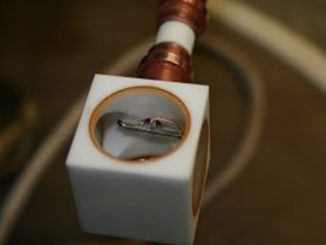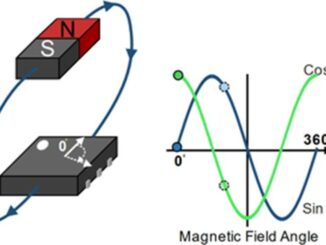Berkeley Lab Researchers Demonstrate Ultra Low-Field Nuclear Magnetic Resonance with an Optical Magnetometer

Earth’s magnetic field, a familiar directional indicator over long distances, is routinely probed in applications ranging from geology to archaeology. Now it has provided the basis for a technique which might, one day, be used to characterize the chemical composition of fluid mixtures in their native environments.
Researchers from the US Department of Energy (DOE)’s Lawrence Berkeley National Laboratory (Berkeley Lab) conducted a proof-of-concept NMR experiment in which a mixture of hydrocarbons and water was analyzed using a high-sensitivity magnetometer and a magnetic field comparable to that of the Earth.
The work was conducted in the NMR laboratory of Alexander Pines, one of the world’s foremost NMR authorities, as part of a long-standing collaboration with physicist Dmitry Budker at the University of California, Berkeley, along with colleagues at the National Institute of Standards and Technology (NIST). The work will be featured on the cover of Angewandte Chemie and is published in a paper titled “Ultra-Low-Field NMR Relaxation and Diffusion Measurements Using an Optical Magnetometer.” The corresponding author is Paul Ganssle, who was a PhD student in Pines’ lab at the time of the work.
“This fundamental research program seeks to answer a broad question: how can we sense the interior chemical and physical attributes of an object at a distance, without sampling it or encapsulating it?” said Vikram Bajaj, a principal investigator in Pines’ group. “A particularly beautiful aspect of magnetic resonance is its ability to gently peer within intact objects, but it’s tough to do that from far away.”
High-field and low-field NMR
The exquisite sensitivity of NMR for detecting chemical composition, and the spatial resolution that it can provide in medical applications, requires large and precise superconducting magnets. These magnets are expensive and immobile. Further, the sample of interest must be placed inside the magnet, such that the entire sample is exposed to a homogeneous magnetic field. This well-developed method is called high-field NMR. The sensitivity of high-field NMR is proportional to magnetic field strength.
But chemical characterization of objects that cannot be placed inside a magnet requires a different approach. In ex situ NMR measurements, the geometry of a typical high-field experiment is reversed such that the detector probes the sample surface, and the magnetic field is projected into the object. A main challenge with this situation is generating a homogeneous magnetic field over a sufficiently large sample area: it is not feasible to generate field strengths necessary to make conventional high-resolution NMR measurements.
Instead of a superconducting magnet, low-field NMR measurements may rely on Earth’s magnetic field, given a sufficiently sensitive magnetometer.
“One nice thing about Earth’s magnetic field is that it’s very homogeneous,” said Ganssle. “The problem with its use in inductively-detected MRI (MRI – magnetic resonance imaging – is NMR’s technological sibling) is that you need a magnetic field that’s both strong and homogeneous, so you need to surround the whole subject with superconducting coils, which is not something that’s possible in an application like oil-well logging.”
“Sensitivity of magnetic resonance depends profoundly on the magnetic field, because the field causes the detected spins to align slightly,” said Bajaj. “The stronger the applied field, the stronger the signal, and the higher its frequency, which also contributes to the detection sensitivity.”
Earth’s magnetic field is indeed very weak, but optical magnetometers can serve as detectors for ultra-low-field NMR measurements in the ambient field alone without any permanent magnets. This means that ex-situ measurements lose chemical sensitivity due to field strength alone. But this method offers other advantages.
Relaxation and diffusion
In high-field NMR, the chemical properties of a sample are determined from their resonance spectrum, but this is not possible without either extremely high fields or extremely long-lived coherent signals (neither of which are possible with permanent magnets). In contrast, relaxation and diffusion measurements in low-field NMR are more than sufficient to determine bulk materials properties.
“The approach at low-field, which you can achieve using permanent magnets or Earth’s magnetic field, is to measure spin relaxation,” said Ganssle. Relaxation refers to the rate at which polarized spin returns to equilibrium, based on chemical and physical characteristics of the system. Additionally, NMR experiments resolve chemical compounds based on their different diffusion coefficients, which depend on the size and shape of the molecule.
A key difference between this and conventional experiments is that the relaxation and diffusion properties are resolved through optically-detected NMR, which operates sensitively even in low magnetic fields.
“A previous achievement of our collaboration has been the development of magnetometers for the detection of NMR,” said Bajaj. “This experiment represents the first time magnetometers have been used to make combined relaxation and diffusion measurements of multi-component mixtures.”
Relaxation and/or diffusion measurements are already commonly used in the oil industry for underground NMR measurements, though conventional probes use a permanent magnet to increase the local magnetic field. There were attempts to perform oil well logging starting in the 1950s using the Earth’s ambient field, but insufficient detection sensitivity led to the introduction of magnets, which are now ubiquitous in logging tools.
“What’s novel here is that using magnetometers, we finally have technology that might be sensitive enough for efficient detection in the Earth’s field, perhaps ultimately enabling detection at longer distances,” said Scott Seltzer, a co-author on the study.
The design was tested in the lab by measuring relaxation coefficients first for various hydrocarbons and water by themselves, then for a heterogeneous mixture, as well as in two-dimensional correlation experiments, using a magnetometer and an applied magnetic field representative of Earth’s.
“This proof of concept might be productively applied in the oil industry,” said Ganssle. “We mixed hydrocarbons and water, pre-polarized them with a magnet, and applied a magnetic field the same as the Earth’s. Then we made measurements with our magnetometer and determined that we had easily enough sensitivity to separate components of oil and water based on their relaxation spectra.”
This technology could help the oil industry to characterize fluids in rocks, because water relaxes at a different rate from oil. Other applications include measuring the content of water and oil flowing in a pipeline by measuring chemical composition with time, and inspecting the quality of foods and any kind of polymer curing process such as cement curing and drying.
The next step involves understanding the depth in a geological formation that could be imaged with this technology.
“Our next study will be tailored to that question,” said Bajaj. “We hope that this technology will eventually peer a meter or more into the formation and elucidate the chemistry within.”
Eventually, probes could be used to characterize entire borehole environments in this way, while current devices can only image inches deep. The combination of terrestrial magnetism and versatile sensing technology again offers an elegant solution.
This research was supported by the US Department of Energy’s Office of Science.



